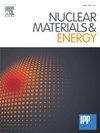Plasma-wall interaction impact of the ITER re-baseline
IF 2.3
2区 物理与天体物理
Q1 NUCLEAR SCIENCE & TECHNOLOGY
引用次数: 0
Abstract
To mitigate the impact of technical delays, provide a more rationalized approach to the safety demonstration and move forward as rapidly as possible to a reactor relevant materials choice, the ITER Organization embarked in 2023 on a significant re-baselining exercise. Central to this strategy is the elimination of beryllium (Be) first wall (FW) armour in favour of tungsten (W), placing plasma-wall interaction (PWI) centre stage of this new proposal. The switch to W comes with a modified Research Plan in which a first “Start of Research Operation” (SRO) campaign will use an inertially cooled, temporary FW, allowing experience to be gained with disruption mitigation without risking damage to the complex water-cooled panels to be installed for later DT operation. Conservative assessments of the W wall source, coupled with integrated modelling of W pedestal and core transport, demonstrate that the elimination of Be presents only a low risk to the achievement of the principal ITER Q = 10 DT burning plasma target. Primarily to reduce oxygen contamination in the limiter start-up phase, known to be a potential issue for current ramp-up on W surfaces, a conventional diborane-based glow discharge boronization system is included in the re-baseline. First-of-a-kind modelling of the boronization glow is used to provide the physics specification for this system. Erosion simulations accounting for the 3D wall geometry provide estimates both of the lifetime of boron (B) wall coatings and the subsequent B migration to remote areas, providing support to a simple evaluation which concludes that boronization, if it were to be used frequently, would dominate fuel retention in an all-W ITER. Boundary plasma (SOLPS-ITER) and integrated core–edge (JINTRAC) simulations, including W erosion and transport, clearly indicate the tendency for a self-regulating W sputter source in limiter configurations and highlight the importance of on-axis electron cyclotron power deposition to prevent W core accumulation in the early current ramp phase. These predicted trends are found experimentally in dedicated W limiter start-up experiments on the EAST tokamak. The SOLPS-ITER runs are used to formulate W source boundary conditions for 1.5D DINA code scenario design simulations which demonstrate that flattop durations of ∼100 s should be possible in hydrogen L-modes at nominal field and current (Ip = 15 MA, BT = 5.3 T) which are one of the principal SRO targets. Runaway electrons (RE) are considered to be a key threat to the integrity of the final, actively cooled FW panels. New simulations of RE deposition and subsequent thermal transport in W under conservative assumptions for the impact energy and spatial distribution, conclude that there is a strong argument to increase the W armour thickness in key FW areas to improve margins against cooling channel interface damage in the early DT operation phases when new RE seeds will be experienced for the first time.
等离子体-壁相互作用对ITER再基线的影响
为了减轻技术延迟的影响,为安全论证提供更合理的方法,并尽快推进反应堆相关材料的选择,ITER组织于2023年开始了一项重要的重新基线工作。该策略的核心是消除铍(Be)第一壁(FW)装甲,转而采用钨(W),将等离子体壁相互作用(PWI)置于新方案的中心位置。切换到W的同时,还需要修改研究计划,其中第一次“开始研究操作”(SRO)活动将使用一个惯性冷却的临时FW,以便在减少中断的情况下获得经验,而不会损坏为后期DT操作安装的复杂水冷面板。对W壁源的保守评估,加上W基座和核心传输的综合建模,表明消除Be对实现ITER主Q = 10 DT燃烧等离子体目标的风险很低。主要是为了减少限制器启动阶段的氧气污染,这是W表面电流上升的潜在问题,在重新基线中包含了传统的基于二硼烷的辉光放电硼化系统。首次采用了硼化辉光模型,为该系统提供了物理规范。考虑到三维壁面几何形状的侵蚀模拟提供了硼(B)壁面涂层寿命和随后B向偏远地区迁移的估计,为一个简单的评估提供了支持,该评估得出结论,如果频繁使用硼化,将在全w ITER中主导燃料保留。边界等离子体(SOLPS-ITER)和集成核心-边缘(JINTRAC)模拟,包括W侵蚀和输运,清楚地表明了在限制器配置下W溅射源的自调节趋势,并强调了轴上电子回旋加速器功率沉积的重要性,以防止W核心在早期电流斜坡阶段积累。这些预测趋势是在EAST托卡马克专用限W器启动实验中发现的。SOLPS-ITER运行用于制定1.5D DINA代码场景设计模拟的W源边界条件,该模拟表明,在标称场和电流(Ip = 15 MA, BT = 5.3 T)的氢l模式下,平顶持续时间应为100 s,这是SRO的主要目标之一。失控电子(RE)被认为是对最终主动冷却的FW面板完整性的主要威胁。在对冲击能量和空间分布的保守假设下,对W中的RE沉积和随后的热输运进行的新模拟表明,有充分的理由增加关键FW区域的W装甲厚度,以提高在第一次经历新RE种子的早期DT操作阶段冷却通道界面损伤的边际。
本文章由计算机程序翻译,如有差异,请以英文原文为准。
求助全文
约1分钟内获得全文
求助全文
来源期刊

Nuclear Materials and Energy
Materials Science-Materials Science (miscellaneous)
CiteScore
3.70
自引率
15.40%
发文量
175
审稿时长
20 weeks
期刊介绍:
The open-access journal Nuclear Materials and Energy is devoted to the growing field of research for material application in the production of nuclear energy. Nuclear Materials and Energy publishes original research articles of up to 6 pages in length.
 求助内容:
求助内容: 应助结果提醒方式:
应助结果提醒方式:


